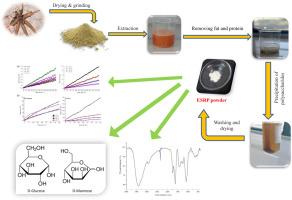Shear-thinning dynamics and viscoelasticity of a novel Eremurus spectabilis glucomannan: Structural insights and implications for food/pharmaceutical applications
IF 6.5
Q1 CHEMISTRY, APPLIED
Carbohydrate Polymer Technologies and Applications
Pub Date : 2025-06-23
DOI:10.1016/j.carpta.2025.100910
引用次数: 0
Abstract
This study aimed to isolate, purify, and characterize the principal water-soluble polysaccharide (ESRP) from E. spectabilis roots and evaluate its structural, thermal, emulsifying, and rheological properties. ESRP exhibited notable in vitro phenolic content and DPPH radical scavenging abilities. Thermal analysis via DSC revealed superior thermal stability, while FT-IR analysis indicated the presence of β-pyranose configuration in its main polysaccharide backbone. GC–MS and analyse revealed a composition of d-glucose (42.77 %), d-mannose (52.82 %), and d-galactose (4.43 %) and presence of degree of O-acetyl groups with a molecular weight of 19.1 kDa. The Zeta potential was negative (–20.97 mV), indicating an anionic nature of ESRP. The aqueous ESRP solutions showed shear thinning behaviour, with viscosity dependent on concentration and temperature. ESRP solutions exhibited pseudo-plastic properties, with lower moduli values compared to inulin. Overall, these findings suggest that ESRP, as a shear-thinning substance, has potential as a novel stabilizer or thickener in various industrial applications.

一种新型葡萄甘露聚糖的剪切变薄动力学和粘弹性:结构见解和对食品/制药应用的影响
本研究旨在分离、纯化和表征从黄芪根中提取的主要水溶性多糖(ESRP),并评估其结构、热、乳化和流变特性。ESRP具有显著的体外酚含量和DPPH自由基清除能力。DSC热分析显示其具有良好的热稳定性,FT-IR分析表明其主要多糖骨架中存在β-吡喃糖构型。GC-MS和分析显示,该产品由d-葡萄糖(42.77%)、d-甘露糖(52.82%)和d-半乳糖(4.43%)组成,并存在一定程度的o -乙酰基,分子量为19.1 kDa。Zeta电位为负(-20.97 mV),表明ESRP具有阴离子性质。ESRP水溶液表现出剪切变薄的行为,粘度取决于浓度和温度。ESRP溶液表现出伪塑性特性,与菊粉相比具有较低的模值。总的来说,这些发现表明,ESRP作为一种剪切减薄物质,在各种工业应用中具有作为新型稳定剂或增稠剂的潜力。
本文章由计算机程序翻译,如有差异,请以英文原文为准。
求助全文
约1分钟内获得全文
求助全文

 求助内容:
求助内容: 应助结果提醒方式:
应助结果提醒方式:


